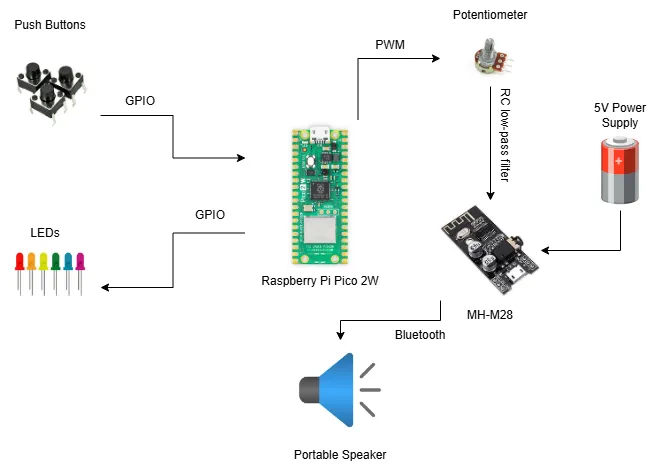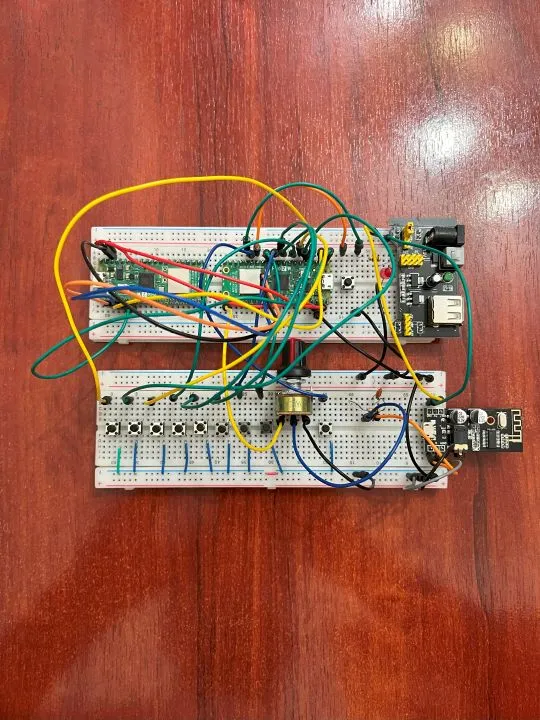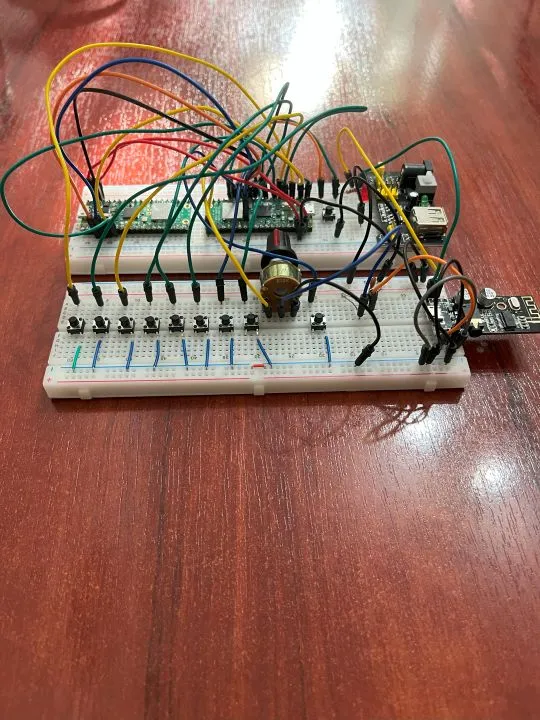Raspberry PI-ANO
A compact digital piano with physical keys, wireless audio output via Bluetooth, and interactive sound modes, built on a Raspberry Pi Pico 2W.
Author: Dragomir Alexandru
GitHub Project Link: https://github.com/UPB-PMRust-Students/project-Alexdr04
Description
This project is built using a Raspberry Pi Pico 2W, seven push buttons for musical notes, a potentiometer for volume control, and a Bluetooth audio module for wireless sound output. It features a loop mode for recording and repeating note sequences, a distortion toggle for creative audio effects, and status LEDs to indicate the current mode.
Motivation
I’ve always enjoyed music and wanted to combine that interest with what I’ve learned about embedded systems. This project gives me a fun, hands-on way to explore PWM audio, GPIO input, and Bluetooth output while building something creative and interactive.
Architecture

Controller:
Raspberry Pi Pico 2W — handles all logic, reads button inputs, and generates audio output via PWM.
Input System:
A set of 7 push buttons for the musical notes and 2 buttons for toggling loop and distortion modes. Connected to the Pico via GPIO.
Audio Processing Unit:
PWM signal from the Pico is passed through a potentiometer for volume control before reaching the Bluetooth module.
Output System:
MH-M28 Bluetooth audio module receives the analog signal and transmits it wirelessly to a portable speaker.
Visual Feedback:
3 LEDs indicate the current playback mode (normal, loop, or distortion). Controlled via GPIO.
Power Supply:
A 5V external power source powers the MH-M28 module separately from the Pico, ensuring stable Bluetooth audio output.
Log
Week 5 - 11 May
After my project was approved, I finalized the component list, ordered everything, and began assembling the hardware. I tested the debugger connection with the Raspberry Pi Pico 2W to ensure proper flashing and communication. I also experimented with basic GPIO inputs and outputs to validate button and LED functionality. Additionally, I started drafting the system schematic in KiCad and planned out the initial wiring layout on the breadboard.
Week 12 - 18 May
This week, I finalized the hardware setup on the breadboard, successfully connecting all components including the buttons, potentiometer, filter, and MH-M28 Bluetooth module. I also began writing the software for handling input, audio output, and mode toggling, and made solid progress toward implementing the core functionality. However, I ran into an issue with the Bluetooth module — it doesn't seem to pair with my portable speaker. I am not entirely sure yet whether the problem is with the module, the speaker, or the way I am using it, but I will investigate further and try different approaches to get it working. If necessary, I will explore replacing the module with one better suited for Bluetooth audio transmission.
Week 19 - 25 May
Hardware
The hardware setup centers around a Raspberry Pi Pico 2W, which serves as the main controller. It is connected to eight push buttons used to trigger musical notes and two additional buttons — one to activate a loop mode that records and replays note sequences, and another to toggle a distortion effect. A single LED provides visual feedback indicating whether the system is currently in distortion mode.
To control output volume, a potentiometer is wired between the PWM output and the signal line, which is passed through a low-pass filter to convert it into an analog audio signal. The audio signal from the Pico is smoothed using a passive RC low-pass filter, composed of a 1 kΩ resistor and a 100 nF ceramic capacitor, which attenuates high-frequency components and converts the PWM signal into a usable analog waveform.
This filtered audio signal is then sent into the MH-M28 Bluetooth module via its L channel input. The MH-M28 transmits audio wirelessly to a paired Bluetooth speaker. It is powered by an external 5V source, while the Raspberry Pi Pico and the rest of the components are powered via USB. A common ground line is shared across all parts of the system to maintain electrical reference integrity.
The full circuit is prototyped on a breadboard, allowing for flexible testing and easy hardware iteration during development.


Schematics
Bill of Materials
| Device | Usage | Price |
|---|---|---|
| Raspberry Pi Pico 2W ×2 | Microcontroller | 39,66 RON ×2 |
| Breadboard 830 points ×2 | Prototyping | 9,98 RON ×2 |
| MH-M28 Bluetooth Module | Audio output | 13,29 RON |
| Rotary Potentiometer 10kΩ | Volume control | 1,99 RON |
| Tactile Button 6x6x6 ×9 | User input | 0,36 RON ×9 |
| Red LED 5mm | Mode indicator | 0,39 RON |
| Resistor 220Ω ×3 | LED limiter | 0,10 RON ×3 |
| Male-to-Male Jumper Wires | Connections | 7,98 RON |
| Male-to-Female Jumper Wires | Connections | 3,99 RON |
| 5V Breadboard Power Supply Module | Power supply | 4,69 RON |
| Ceramic Capacitor 100nF | Low-pass filter | 0,69 RON |
Software
| Library | Description | Usage |
|---|---|---|
| embassy | Asynchronous framework for embedded development in Rust | Used to handle GPIO events and multitasking |
| rp2040-hal | Hardware Abstraction Layer for Raspberry Pi RP2040 microcontrollers | Provides access to GPIO, ADC, PWM, and other peripherals |
| embedded-hal | Generic traits for embedded hardware abstraction | Interfaces with drivers like LEDs and buttons |
| defmt | Lightweight logging crate for embedded systems | Debugging and formatted logging |
| probe-rs | Debug probe support for Rust-embedded development | Used to flash firmware and debug via the second Pico |
| heapless | Data structures without dynamic memory allocation | Used for storing note sequences in loop mode |
